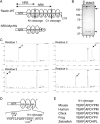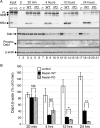Cleavage within Reelin repeat 3 regulates the duration and range of the signaling activity of Reelin protein
- PMID: 24644294
- PMCID: PMC4007479
- DOI: 10.1074/jbc.M113.536326
Cleavage within Reelin repeat 3 regulates the duration and range of the signaling activity of Reelin protein
Abstract
Reelin is a secreted glycoprotein that plays essential roles in the brain. Reelin is specifically cleaved at two distinct sites, called N-t and C-t, with the former being the major one. N-t cleavage can occur both in the extracellular space and in the endosomes, although the physiological importance of endosomal N-t cleavage has not been investigated. In this study, we first determined the exact N-t cleavage site catalyzed by a protease secreted by cerebral cortical neurons. Cleavage occurred between Pro-1244 and Ala-1245 within Reelin repeat 3. A Reelin mutant in which Pro-1244 was replaced with aspartate (Reelin-PD) was resistant to a protease secreted by cultured cerebral cortical neurons, and its biological activity stayed active longer than that of wild-type Reelin. Interestingly, Reelin-PD remained in the intracellular compartments longer than wild-type Reelin and persistently activated downstream signaling. Therefore, N-t cleavage of Reelin is required for halting the signaling machinery in the extracellular space as well as within endosomes of target neurons. We established a monoclonal antibody specific to uncleaved Reelin protein and found that it is localized in the vicinity of Reelin-producing cells, whereas the N-terminal fragment diffuses, or is transported, to distant regions. These data demonstrate that N-t cleavage of Reelin plays critical roles in regulating the duration and range of Reelin functions both in the extracellular milieu and in the intracellular compartments.
Keywords: ADAM ADAMTS; Brain; Dab1; Endosomes; Neurons; Protein Degradation; Reelin; Signal Transduction.
Figures







Similar articles
-
C-terminal region-dependent change of antibody-binding to the Eighth Reelin repeat reflects the signaling activity of Reelin.J Neurosci Res. 2009 Nov 1;87(14):3043-53. doi: 10.1002/jnr.22143. J Neurosci Res. 2009. PMID: 19530167
-
Secreted Metalloproteinase ADAMTS-3 Inactivates Reelin.J Neurosci. 2017 Mar 22;37(12):3181-3191. doi: 10.1523/JNEUROSCI.3632-16.2017. Epub 2017 Feb 17. J Neurosci. 2017. PMID: 28213441 Free PMC article.
-
The Secreted Glycoprotein Reelin Suppresses the Proliferation and Regulates the Distribution of Oligodendrocyte Progenitor Cells in the Embryonic Neocortex.J Neurosci. 2020 Sep 30;40(40):7625-7636. doi: 10.1523/JNEUROSCI.0125-20.2020. Epub 2020 Sep 10. J Neurosci. 2020. PMID: 32913108 Free PMC article.
-
[Functions of Reelin in cortical neuron migration].Seikagaku. 2016 Feb;88(1):105-13. Seikagaku. 2016. PMID: 27025013 Review. Japanese. No abstract available.
-
Role for Reelin in stabilizing cortical architecture.Trends Neurosci. 2010 Sep;33(9):407-14. doi: 10.1016/j.tins.2010.06.001. Epub 2010 Jul 1. Trends Neurosci. 2010. PMID: 20598379 Review.
Cited by
-
Importance of Reelin C-terminal region in the development and maintenance of the postnatal cerebral cortex and its regulation by specific proteolysis.J Neurosci. 2015 Mar 18;35(11):4776-87. doi: 10.1523/JNEUROSCI.4119-14.2015. J Neurosci. 2015. PMID: 25788693 Free PMC article.
-
Extracellular proteolysis of reelin by tissue plasminogen activator following synaptic potentiation.Neuroscience. 2014 Aug 22;274:299-307. doi: 10.1016/j.neuroscience.2014.05.046. Epub 2014 Jun 2. Neuroscience. 2014. PMID: 24892761 Free PMC article.
-
Disease-Specific Changes in Reelin Protein and mRNA in Neurodegenerative Diseases.Cells. 2020 May 19;9(5):1252. doi: 10.3390/cells9051252. Cells. 2020. PMID: 32438605 Free PMC article.
-
Relevance of the Proteolytic Processing of Reelin by ADAMTS-3 in Brain Functions.J Neurosci. 2017 Jul 19;37(29):6814-6815. doi: 10.1523/JNEUROSCI.1077-17.2017. J Neurosci. 2017. PMID: 28724754 Free PMC article. No abstract available.
-
New Insights into Reelin-Mediated Signaling Pathways.Front Cell Neurosci. 2016 May 9;10:122. doi: 10.3389/fncel.2016.00122. eCollection 2016. Front Cell Neurosci. 2016. PMID: 27242434 Free PMC article. Review.
References
-
- Tissir F., Goffinet A. M. (2003) Reelin and brain development. Nat. Rev. Neurosci. 4, 496–505 - PubMed
-
- Tiberi L., Vanderhaeghen P., van den Ameele J. (2012) Cortical neurogenesis and morphogens: diversity of cues, sources and functions. Curr. Opin. Cell Biol. 24, 269–276 - PubMed
-
- Park H., Poo M. M. (2013) Neurotrophin regulation of neural circuit development and function. Nat. Rev. Neurosci. 14, 7–23 - PubMed
-
- Baker K. A., Moore S. W., Jarjour A. A., Kennedy T. E. (2006) When a diffusible axon guidance cue stops diffusing: roles for netrins in adhesion and morphogenesis. Curr. Opin. Neurobiol. 16, 529–534 - PubMed
-
- Rogers K. W., Schier A. F. (2011) Morphogen gradients: from generation to interpretation. Annu. Rev. Cell Dev. Biol. 27, 377–407 - PubMed
Publication types
MeSH terms
Substances
LinkOut - more resources
Full Text Sources
Other Literature Sources
Research Materials

